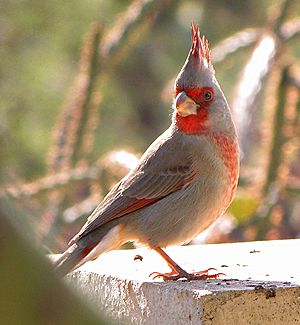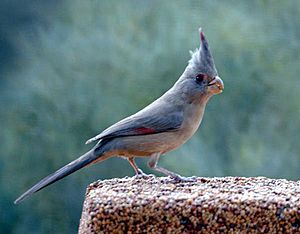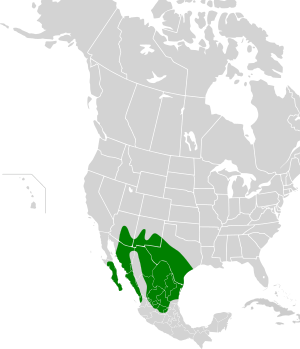Pyrrhuloxia facts for kids
Quick facts for kids Pyrrhuloxia |
|
|---|---|
 |
|
| Male in Tucson, Arizona, US | |
 |
|
| Female | |
| Conservation status | |
| Scientific classification | |
| Genus: |
Cardinalis
|
| Species: |
sinuatus
|
 |
|
The pyrrhuloxia (say "peer-uh-LOX-ee-uh"), also known as the desert cardinal, is a medium-sized songbird. You can find it in the southwestern parts of the United States and northern Mexico. This special bird has a short, strong beak, a red crest on its head, and red wings. It looks a lot like the Northern cardinal and the Vermilion cardinal, which are its close relatives.
Contents
About the Desert Cardinal
The desert cardinal is one of three birds in the Cardinalis group. These birds belong to the family Cardinalidae, which are passerine birds found in North and South America.
What's in a Name?
The name "pyrrhuloxia" comes from old Greek words.
- Pyrrhos means "reddish" or "orange," describing the bird's colors.
- Loxos means "oblique" or "crooked," which describes the shape of its beak.
The common name, "desert cardinal," tells us where it lives: in the dry, desert areas of North America.
What Does a Pyrrhuloxia Look Like?
The desert cardinal is a medium-sized songbird. Both males and females are about 8.3 inches (21 cm) long. They usually weigh between 0.8 and 1.5 ounces (24–43 grams).
Spotting the Differences
The male desert cardinal looks different from the male Northern cardinal.
- The desert cardinal is mostly brownish-gray.
- It has a red chest, a red "mask" around its eyes, and a yellow, parrot-like beak.
- Its beak is strong and rounded.
Female pyrrhuloxias and northern cardinals look more alike. However, their beaks are shaped differently, which helps tell them apart. Both types of cardinals have a long, pointed red crest on their heads. The songs of the two species sound the same, but the pyrrhuloxia's song is a bit quieter.
Where Do Pyrrhuloxias Live?
The pyrrhuloxia lives all year round in desert areas. It likes scrublands and thickets of mesquite trees. You can find it in the U.S. states of Arizona, New Mexico, and Texas. It also lives along the edges of woodlands in Mexico.
Their Home Range
Its home range covers the southwestern half of Texas, the southern third of New Mexico, and southeastern Arizona. In Mexico, it lives from the west to the east coast, north of certain mountain ranges. These birds usually stay in their home areas and do not migrate far. Sometimes, they might wander a little north of their usual range. Pyrrhuloxias prefer to live near stream beds. In places where the desert cardinal and northern cardinal live in the same area, they might sometimes hybridize, meaning they can have babies together.
Pyrrhuloxia Life and Habits
During the breeding season, male pyrrhuloxias sing to claim and protect their territory. One of their songs sounds like a sharp, clear "wha-cheer, wha-cheer." Another song sounds like a metallic "quink." Female pyrrhuloxias also sing, but their notes are softer. Both male and female birds make a short "cheep" or "chip" sound when they are looking for food.
What Do Pyrrhuloxias Eat?
The pyrrhuloxia's diet includes seeds, fruits, and insects. When they look for food, they catch insects from trees. They also pick seeds from the stalks of grasses and other plants. They enjoy eating cactus fruit too. These birds are helpful to cotton fields because they eat cotton worms and weevils, which are pests. In winter, these cardinals visit bird feeders and gather in large groups, sometimes with thousands of birds.
Reproduction and Life Cycle
The breeding season for the desert cardinal usually starts in mid-March and ends in mid-August. As this time gets closer, the male bird finds and protects his territory. He defends it by chasing away other birds and singing from a good spot. Even when desert cardinals and northern cardinals live in the same area, they do not usually fight over territories.
The desert cardinal builds its nest in thick bushes, often hidden. The nest is small and shaped like a bowl or cup. It is made from grass, twigs, or pieces of tree bark. Females usually lay two to four eggs. The eggs are whitish with small green or gray spots. The female sits on the eggs for about two weeks to keep them warm. During this time, the male brings her food. When the chicks hatch, they are helpless and have bright yellow beaks with red insides. The chicks leave the nest when they are about 10 days old. Both the male and female parents take care of the young birds. Young birds might stay with their parents for up to a month before they can fly well and find their own food. After this, they join large groups of other young birds.
Pyrrhuloxias and People
Sadly, large areas where pyrrhuloxias live in the northern part of their range have been lost because of human development. Because of this, the number of pyrrhuloxias seems to be slowly decreasing. This is different from the northern cardinal, whose numbers are more stable.
Photo gallery
-
Male in Tucson, Arizona
-
Male in Roma, Texas
-
Male in Columbus, New Mexico
See also
 In Spanish: Cardenal pardo para niños
In Spanish: Cardenal pardo para niños







